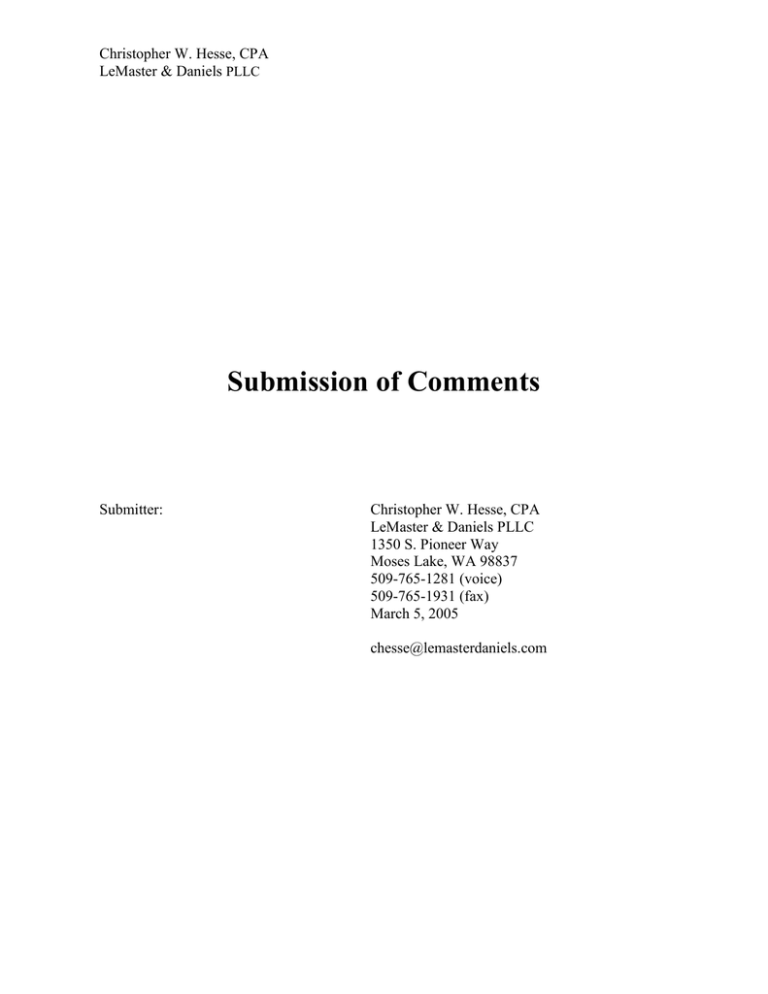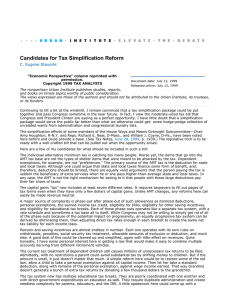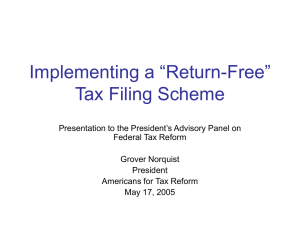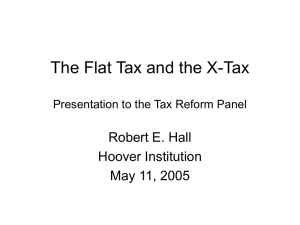Submission of Comments
advertisement

Christopher W. Hesse, CPA LeMaster & Daniels PLLC Submission of Comments Submitter: Christopher W. Hesse, CPA LeMaster & Daniels PLLC 1350 S. Pioneer Way Moses Lake, WA 98837 509-765-1281 (voice) 509-765-1931 (fax) March 5, 2005 chesse@lemasterdaniels.com Christopher W. Hesse, CPA LeMaster & Daniels PLLC chesse@lemasterdaniels.com 509-765-1281 (voice) 509-765-1931 (fax) March 5, 2005 Headaches, unnecessary complexity, and burdens: In 25 years of experience, it becomes increasingly more difficult to prepare income tax returns, especially individual income tax returns, without the benefit of the computer. For our clientele, we are assured of phase-outs, phase-ins and elections which require recomputation due to the smallest change in adjusted gross income or taxable income. Elections provided in order to “simplify” income taxes result in multiple computations in order to determine which alternative among many result in the lowest overall tax liability. For example, a Section 179 deduction of $102,000 requires the tax advisor to review varying deduction levels to target a specific taxable income, not just for the current year, but taking into account the reduced depreciation that will be available in future years. Changing income tax rates and laws due to the scoring of tax bills result in planning, not for just one tax year, but over periods of ten years or more as effects of scheduled changes are considered. In addition, few believe the scheduled changes in the tax law will remain as stated in the original law; expectations for additional changes and extensions of tax provisions exist, requiring taxpayers to gaze into the crystal ball to plan appropriately. Aspects of the tax system that are unfair: The Internal Revenue Code provides for six stated tax brackets, but in reality, the number of tax brackets is nearly infinite. For example, a Social Security recipient may experience a 22.5% tax bracket as 50% of Social Security benefits become taxable, even though the taxpayer is in the stated 15% tax bracket. Likewise, additional capital gain income Christopher W. Hesse, CPA LeMaster & Daniels PLLC chesse@lemasterdaniels.com 509-765-1281 (voice) 509-765-1931 (fax) March 5, 2005 received in the phase-in period results in a higher than the stated 5% capital gains tax rate. All phase-outs have a similar effect. The examples, as with the tax brackets, are nearly endless. Taxpayers may believe that they are subject to a 25% tax bracket, but with credit and deduction phase-outs, substantially greater effective marginal rates occur. Rather than provide phase-outs and phase-ins, the Internal Revenue Code should be written to be more “honest” in its application. If a taxpayer is in the 25% tax bracket, an additional $10,000 of taxable income should result in an additional $2,500 of tax. That is rarely the case. The phase-ins and phase-outs should be eliminated with the tax difference provided through an increase in the stated tax rate. Phase-ins and phase-outs are patently unfair. If it is appropriate that a taxpayer be granted a deduction for itemized deductions, such deductions should not be reduced merely because the taxpayer has greater taxable income. The taxpayer is already subject to higher tax brackets due to earning higher taxable income. The phase-out of deductions and credits is a “hidden tax,” a surtax if you will. Income taxes should be transparent. In addition to the unfairness of phase-ins and phase-outs, the Alternative Minimum Tax needs to be re-worked. Originally intended to require higher income taxpayers to pay a minimum amount of tax, the AMT is now affecting middle-income taxpayers. Since the maximum AMT rate is 28% (for individuals), taxpayers in the higher brackets are less Christopher W. Hesse, CPA LeMaster & Daniels PLLC chesse@lemasterdaniels.com 509-765-1281 (voice) 509-765-1931 (fax) March 5, 2005 likely to be subject to the AMT. As income rises, the taxpayer is less likely to be subject to AMT (additional income is subject to a 28% AMT but perhaps a 35% regular tax rate). The AMT should have 10% and 15% brackets, together with a smaller exemption, so that lower-earning taxpayers are not as likely to be subject to the tax. And such brackets and exemption should be indexed for inflation, as are the regular tax brackets. Those items which are not viewed as “tax preference items” should not be subject to the AMT. Taxpayers are being subject to AMT solely due to personal exemptions and the standard deduction. Other taxpayers are subject to AMT due to state tax deductions, something not within the control of the taxpayer. The regular tax provides certain tax incentives (accelerated depreciation, for example). The AMT was created so that taxpayers who received too many tax incentives would pay a minimum amount of tax. The AMT has evolved beyond this original intent, now trapping unsuspecting taxpayers and those who otherwise have no control over their tax situation. The current tax system promotes an amount of “class warfare.” “When a government robs Peter to pay Paul, it can always count on the support of Paul.”—George Bernard Shaw. This is truer today, when 50% of the taxpayers pay over 96% of the income tax. The system will collapse, as the lower-earning 50% vote themselves ever-increasing benefits from the Federal government, requiring ever-increasing taxes to be paid from the other 50%. Tax Code distorts business or personal decisions: Christopher W. Hesse, CPA LeMaster & Daniels PLLC chesse@lemasterdaniels.com 509-765-1281 (voice) 509-765-1931 (fax) March 5, 2005 The Internal Revenue Code discourages taxpayers to be employees. Taxpayers see neighbors who own their own businesses drive “business” automobiles and pickups for personal use. It is commonly believed that self-employed persons have the ability to deduct substantial expenses that, for an employee, become worthless deductions as 2% miscellaneous itemized deductions. The increased standard deduction changes economic behavior. Taxpayers target state taxes and charitable contributions for every other year. The home mortgage interest deduction encourages home ownership, but to what end (an “American Dream”)? Home mortgage interest is already subsidized through Fannie Mae. The home equity interest deduction encourages the taxpayer to secure a debt with the house, perhaps the last asset that should be used as security. Business expenses should be allowed as deductions because the expenditure is an appropriate economic decision, not because there is a tax incentive provided. If the U.S. tax rate is too high, thereby requiring a separate incentive to encourage “research and experimentation,” the answer should be to lower the tax rate on business, not to draft a separate, unworkable scheme for “incremental research” that is not possible to define and more difficult to enforce. Corporations should not be subject to a double tax. Dividends paid should be allowed as deductions, akin to interest expense, to eliminate the distinctions between equity and debt Christopher W. Hesse, CPA LeMaster & Daniels PLLC chesse@lemasterdaniels.com 509-765-1281 (voice) 509-765-1931 (fax) March 5, 2005 financing which cause considerable complexity. The non-deductibility of dividends encourages the use of partnership and S corporation taxation, which further discourage business decisions without first determining the effect, tax-wise, on the individual owners. Integrating the corporate-individual tax system by allowing the deductibility of dividends (and not the non-taxation of dividend income to the recipient) will greatly increase efficiency in the tax planning and reporting system. Goals that the Panel should try to achieve: The Panel should seek a tax system that does not distort economic decisions made or to be made by the taxpayer. In addition, the tax system should not create, encourage or continue a “class warfare” system. All who receive benefits from the Federal government should have a stake in its tax system. The tax system should not be used for social policy. Social incentives (child credit, dependent care credit, earned income credit, home mortgage deduction, charitable contributions deduction, medical expense deductions, education incentives, to name a few) should be accounted for on the expenditure side of the government ledger, not as reductions from the revenue. It is dishonest to do so otherwise. The tax system should be economically neutral. The tax system should be used to fund the government. Economic decisions are best left to the laws of supply and demand.


